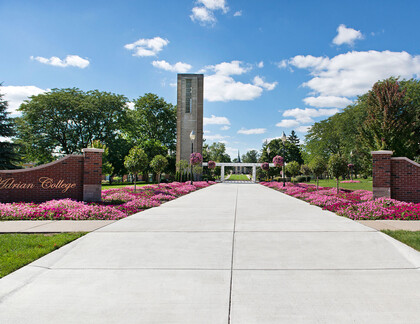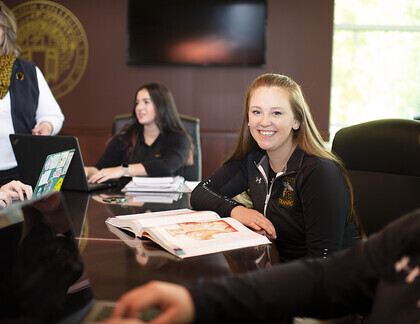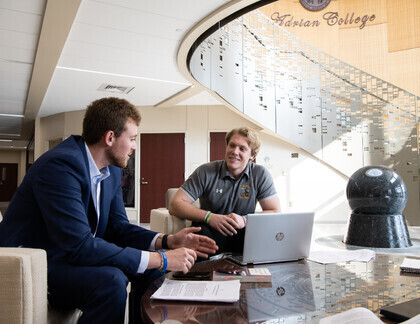Why Adrian?
Whatever your background, Adrian College can provide you with the skills and experience you need to realize your dreams.

Why Adrian?
Whatever your background, Adrian College can provide you with the skills and experience you need to realize your dreams.

Undergraduate Studies
We offer an undergraduate program of study that’s small enough to be personal

Graduate Studies
Pursuing your dream career starts with the next phase of your education. When you enroll in graduate school at Adrian College, you’re beginning more than advanced training in your field; you’re accelerating your professional journey.
Posted Thursday, March 28, 2024
Author: From "A Pictorial History of Adrian College"
On a cold night in Leoni, Michigan, in 1859, a group of students and faculty from Michigan Union College loaded an oxcart with valuable books from the library and the student literary society. This was no prank. In fact, they were deadly serious about their seemingly impossible task: surreptitiously moving the college to an entirely new city. Driven by a desire for greater community funding - and few distilleries - the college's leadership had determined that a new home was needed. In fact, officials had selected the booming town of Adrian, sixty miles southeast of Leoni, as the new home for their school. But when news of the impending move leaked out, locals had called in county officials to keep the college in place.
Dismayed but undeterred, a small group hatched a plan to smuggle the few valuable items that the college owned out under cover of darkness, and make the long trek to Adrian. In spite of policing by local law enforcement, the group and its book-laden cart successfully fled Leoni, rambling over the sixty arduous miles and finally reaching their new home in Adrian. Thus Adrian College was born. Though the story has undoubtedly been embellished over the years, historical accounts back up this dramatic tale of Adrian College's birth.
The school's official history dates to the charter granted on March 28, 1859, but the college was actually a continuation of Michigan Union College and Leoni Theological Institute before it.
Leoni, Michigan, was a small town with strong connections to the Methodist church. The Methodists had split into several factions in the 1800s for a variety of reasons. The Methodist Protestants split from the larger church in 1828 because of growing fears about church governance and the concentration of power in the hands of the clergy. The Wesleyan Methodists were staunch abolitionists and proponents of women's rights and broke with the larger church in 1843 over those issues. While neither branch completely agreed with the other about church matters, they were both very interested in higher education, and both were interested in establishing schools in Leoni. Only the Wesleyans were successful, but as we will see, the Methodist Protestants did not abandon their dream of a college in southeast Michigan.
The Wesleyans founded Leoni Theological Institute in 1845, and Leoni Seminary, a preparatory school, in 1848. Leoni Theological Seminary changed its name in 1855 to become Michigan Union College, and may have incorporated students from the Leoni Seminary, although the historical record is unclear. By 1855, the school had more than three hundred students, almost all of whom were in the preparatory school. Fifteen men and four women were engaged in college work.
While Leoni had initially seemed like a good location for a Methodist seminary, it had a few problems. There was a whiskey distillery in town which the abstemious Wesleyans strongly opposed and worked furiously to relocate. Then, in the 1850s, a number of local farmers were convicted of setting fire to the Detroit railroad depot, which did not provide food publicity for the town or college. Leoni was also quickly being overshadowed by neighboring Jackson, a railroad hub. In addition to these concerns, the college was desperately short on funds that neither the town nor the Wesleyan denomination seemed able to provide. In 1859, the college leaders called a town meeting to address the problem, and it was at this meeting that the Reverend Asa Mahan stepped forward with a proposal to move the college to Adrian.
Mahan moved to Michigan in 1855 to become pastor of the First Congregational Church in Jackson. While there, he occasionally visited Michigan Union College as a featured speaker of their student literary society. Two years later, he left Jackson for Plymouth Congregational Church in Adrian. By 1859, Mahan was well known in Methodist circles as the former president of Oberlin College and a proponent of Christian Perfectionism. His commitment to abolition drew him to Jackson and Adrian, where the underground railroad thrived.
As word spread the Michigan Union was in dire straits, various locales expressed their interest in housing the college. Colleges were a sign of prestige for communities, and brought with them culture and consumers of local goods. Jackson wanted the college for its community, and the local newspaper printed several articles trying to rouse support. Faced with this competition, Asa Mahan knew he needed to take quick and decisive action to secure the college for Adrian. Mahan, who had already led two colleges, was eager to dive into the academic world again, and Adrian seemed an ideal place for him to reestablish Michigan Union. Adrian was the second-largest city in the state at that point, and there was interest in the town for the college. The support was so great, in fact, that within six weeks the townspeople raised $30,000 for the charter and donated the twenty acres of land on which to build. After a quick succession of town meetings a deal was made, and on March 28, 1859, Michigan Union College was officially reincorporated as Adrian College.
The town quickly got to work on the first buildings for the college. Mahan hoped the two key buildings would be ready for the fall, but construction was not complete, so the inaugural semester was delayed until December 1, 1859, when North and South Halls opened their doors to the first students of Adrian College.
The college inherited more from Michigan Union College than library books; several faculty members and students traveled over to Adrian to join the new college community. Students who were members of the Philomatheon and Excelsior Literary Societies at Michigan Union - their books were in the oxcart - reformed at Adrian as the Star Literary Society. They were joined by several of their professors. The McKeevers comprised one-third of the new Adrian faculty, with Isaac teaching chemistry and natural history, his wife Elizabeth teaching drawing and pairing, and his sister Susan teaching instrumental music. John McEldowney and Adam Lowrie not only taught at Adrian, but both served short terms as presidents of the college. John McEldowney's brother, James, was hired to teach mathematics and astronomy. In addition, Rev. Luther Lee, a well-known Methodist preacher who had briefly been president of Michigan Union College, taught theology for several years at Adrian.
While the school continued its connection to the Wesleyan Methodists, it was clear from the outset it would also be a college for locals, irrespective of their religious affiliation. The board of trustees for the new Adrian College mandated that half their members be Adrian residents and the other half Wesleyans. It was also clear that the college would continue to embody the abolitionist and coeducational ideals dear to both the Wesleyans and Mahan.
Students of all races and genders were admitted to Adrian, and women were fully integrated into the curriculum as students and instructors. Very few colleges in 1859 admitted women, and those that did mostly required them to take separate degree programs than male students.
Adrian College students initially had three curricular options: a two-year preparatory degree (similar to the last two years of a modern high school degree), a Bachelor of Arts degree, and a Bachelor of Science degree. There were 212 students the first year of Adrian's operation, 78 of whom were women, but there were no seniors. Most of the students - 166 of them - were in the preparatory program. Despite the lack of graduates, the college held its first commencement exercises in June of 1860, marked by a variety of speeches, orations, and performances by professors and students. The cornerstone for the Chapel building (now Downs Hall) was laid, with Professor Luther Lee recreating his famous oration over John Brown's grave for the occasion.
While Adrian College was still in its infancy, the Civil War erupted and the college was swept into the conflict. Many students enlisted and left the campus to fight. The campus itself served in 1861 and 1864 as training grounds for Union troops. Asa Mahan's son enlisted and later died at Fredericksburg, and one of his daughters served with the sanitary commission. Mahan himself was deeply interested in military tactics, and developed his own war strategy that he shared with the Secretary of the Treasury, Salmon Chase, with whom he was acquainted. Chase liked Mahan's ideas enough to get him an audience in 1862 with the Secretary of War, Edwin Stanton, and eventually with President Abraham Lincoln himself.
As if the war weren't disruptive enough, Adrian College quickly found itself in financial straits. Michigan Union College had failed because of lack of support from the Wesleyans, and the situation was repeating itself in Adrian. Part of the problem was with the Wesleyan denomination itself. As previously mentioned, it had split from the Methodist Church over slavery. But when the larger Methodist Protestant (MP) group also divided over slavery in 1858, many Wesleyans decided to join them. This left the remaining Wesleyans weaker and poorer and thus less able to support their college. Additionally, the majority of Wesleyan congregations were in Ohio and Pennsylvania; Adrian did not even have a Wesleyan church in town. Many Wesleyans were reluctant to send their children to a school so far away from home when they had other Wesleyan colleges nearby. Other difficulties lay with the town itself. Event though the community had actively worked to establish the college in Adrian, they were by turns unable and unwilling to provide enough money to solely support the school. Adrianites might have liked a school that catered to their children and their region exclusively, but the school remained committed to its Methodist heritage and the community did not have the means to support the college without the church. As a result, the school that had started with such promise as a join venture between the church and locals in Adrian quickly found itself neglected by both groups, a situation that would repeat itself many times over the next one hundred years.
Mahan, aware of the problems, urged the board of trustees to approach the Methodist Protestants about joint ownership of the college. The Wesleyans had worked with MPs at Leoni, and there had been some talk at the inception of Adrian of making the school a collaborative venture, but it didn't develop. Now seemed an opportune time to appeal to the MPs as partners. The local trustees - and several of the Wesleyan trustees - approved of the idea, so Mahan was dispatched to court the MPs. He did so successfully, and in 1863 came to the board of trustees meeting with MP representatives ready to make a deal. But to much surprise, the Wesleyans on the board now denounced the idea, claiming that many in their denomination objected to the proposal. Mahan and the MPs were frustrated by this turn of events. Mahan desperately wanted to save Adrian College, and he felt this was the only way. The MPs were set on having a college, and if it wasn't Adrian, it would be somewhere else, which would hurt Adrian's chances of survival. Feeling rebuffed by the college, Mahan continued to work with the MPs to help them to build a college, raising a good amount of money on their behalf. He spent so much time away from Adrian working for the mPs that the trustees declared the presidency of the college vacant, and appointed John McEldowney - former president of Michigan Union - to the position in 1864. With Mahan away, the college continued to founder. Local trustees were frustrated with the Wesleyans' lack of financial support, and in 1866 they appealed to Mahan and the MPs again. However, this time they were not offering a partnership; instead, they offered the college to the MPs outright, and the MPs agreed. There was some protest in Wesleyan quarters, but the college's financial troubles were serious enough to outweigh most objections. Still, three Wesleyan trustees, including John McEldowney and Luther Lee, resigned over the transfer of power. Mahan returned to Adrian in 1866, resuming the presidency of the college in 1867 and remaining until his retirement from academia in 1871.
Under the control of the MPs, the college's financial situation stabilized, though it was never completely secure. The trustee minutes for the next seventy-five years show a constant need for additional funds, and in some years the college came precariously close to relocating or closing completely. The problems that were present at Adrian's beginning plagued the school for years to come - they were too far from established ML congregations and locals didn't have enough money to fully support the school themselves. In addition, not everyone in the ML church or in the local community believed in the need for a college education. In all, Adrian fended off two attempts to move the school and two further requests from the Methodists to either close or reconfigure as a junior college. Additionally, there were a number of years when enrollments were dangerously low and funding was extremely tight; professors were paid in promissory notes, and the power was nearly shut off. At times like these, the college seemed to unofficially adopt the class motto "No Victory without Work" - inscribed on the Shepherd's Crook - as its mantra. Led by devoted staff, trustees, and students, Adrian College refused to give up; it persevered through hard times and survived where other schools failed.